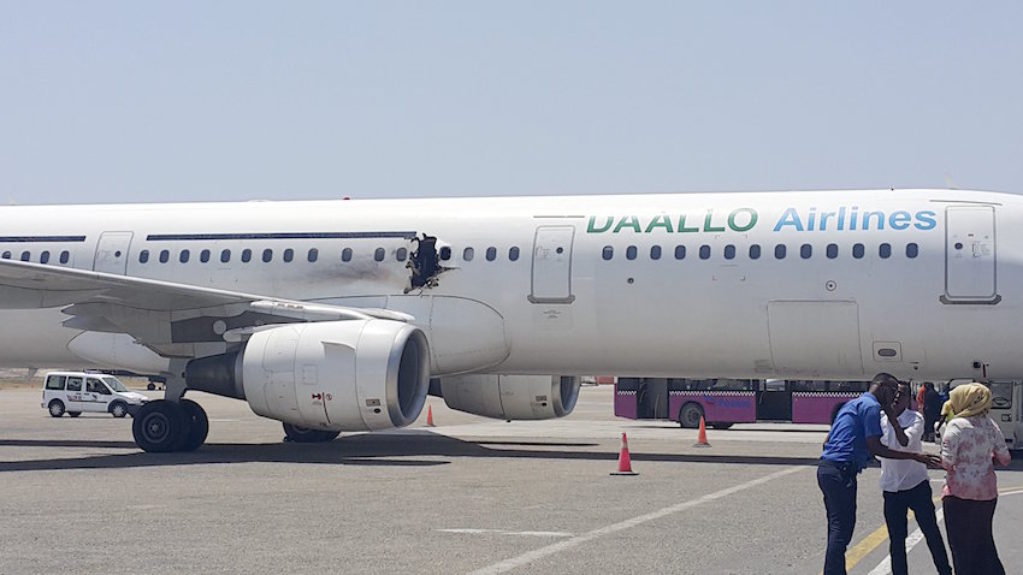What’s really behind Trump’s laptop ban
BY
THOMAS JOSCELYN | March 23, 2017 |
[email protected] |
@thomasjoscelyn

Shabaab, al Qaeda’s branch in Somalia, detonated a laptop bomb on this Daallo Airlines aircraft in February 2016.
[
Editor’s note: this article was originally published at Politico.]
More than 15 years after the September 11 hijackings, the U.S. government has issued yet another warning about airline security. On Tuesday, the Department of Homeland Security (DHS) announced new restrictions on electronics brought on board certain U.S.-bound flights. Passengers on planes leaving from 10 airports throughout the Middle East and North Africa will no longer be able to carry laptops or similar electronics with them into the cabin of the plane. Cell phones and smaller electronics are unaffected by the new measures, but computers will have to be checked in luggage.
The move instantly generated controversy and questions. Namely, why now? Some dismissed the DHS announcement as a protectionist move aimed at boosting the futures of U.S. carriers, who have complained of unfair competition from Gulf airlines for years. Twitter wags called it a “Muslim laptop ban,” whose secret aim was to discourage travel from the Arab world. But by now it should be clear that the new restrictions are deadly serious, even if there are legitimate questions about how it is being implemented.
Initial press reports, including by the
New York Times, cited anonymous officials as saying that the restrictions were not a response to new intelligence. But the DHS announcement implies otherwise. One question on the DHS web site
reads, “Did new intelligence drive a decision to modify security procedures?” The answer: “Yes, intelligence is one aspect of every security-related decision.” The British government’s quick decision to follow suit also suggests that something new is afoot here.
Subsequent reports from
CNN and
The Daily Beast indicate that intelligence collected during a U.S. Special Forces raid in Yemen in January led to the restrictions. That is possible. The raid was highly controversial, but the Trump administration argues the costs were worth it because the U.S. learned key details about al Qaeda in the Arabian Peninsula’s (AQAP) plotting. A Navy SEAL perished during the operation, as did a number of women and children. Within hours, jihadists began circulating a photo of an adorable little girl who died in the crossfire. The girl was the daughter of Anwar al Awlaki, a Yemeni-American al Qaeda ideologue killed in a September 2011 drone strike. Al Qaeda immediately called for revenge in her name.
Whether new intelligence led to the decision or not, we already know for certain that al Qaeda has continued to think up ways to terrorize the skies. For years, Al Qaeda operatives in Somalia, Syria, Yemen and elsewhere have been experimenting with sophisticated explosives that can be smuggled onto planes.
DHS
points to the “attempted airliner downing in Somalia” in February 2016 as one reason for ongoing concerns. That bombing was carried out by al Shabaab, al Qaeda’s official branch in Somalia. Al Shabaab attempted to justify the failed attack by
claiming “Western intelligence officials” were on board the flight, but that excuse may be a cover for something more sinister.
Some U.S. officials suspect that al Qaeda’s elite bomb makers wanted to test one of their newest inventions, a lightweight explosive disguised as a laptop that is difficult to detect with normal security procedures. At the very least, Shabaab’s attack demonstrated that al Qaeda has gotten closer to deploying a laptop-sized explosive that can blow a hole in jetliners. While no one other than the terrorist who detonated the bomb was killed, the plane was left with a gaping hole in its side.
Al Qaeda-linked terrorists have tested their contraptions before. In December 1994, a bomb was detonated on board a Philippine Airlines flight, killing one of the passengers and severely damaging the plane. The device was implanted by Ramzi Yousef, the nephew of 9/11 mastermind Khalid Sheikh Mohammed. Yousef planned to blow up several airliners at once as part of “Project Bojinka” and he wanted to try out his invention beforehand. Authorities ultimately scuttled his plot, but al Qaeda didn’t forget Yousef’s idea. Instead, the terrorist organization returned to it again in 2006, when a similar plan targeting jets leaving London’s Heathrow Airport was foiled.
Al Qaeda’s failure in 2006 didn’t dissuade the group from pressing forward with a version of Yousef’s original concept, either.
In September 2014, the U.S. began launching airstrikes against an al Qaeda cadre in Syria described by the Obama administration as the “Khorasan Group.” There was some initial confusion over what the Khorasan Group really is, with some opining that it was simply invented by American officials to justify bombings, or a separate terror entity altogether. In reality, it was simply a collection of al Qaeda veterans and specialists who were ordered by the group’s leader, Ayman al Zawahiri, to begin laying the groundwork in Syria for operations against the West.
As far as we know, the Khorasan Group never did attempt to strike the U.S. or Europe. Perhaps this is because a number of its leaders and members were killed in the drone campaign. But there is an additional wrinkle in the story: Zawahiri didn’t give his men the final green light for an operation. Instead, Zawahiri wanted the Khorasan cohort to be ready when called upon. In the meantime, al Qaeda
didn’t want an attack inside the West to jeopardize its primary goal in Syria, which is toppling Bashar al Assad’s regime.
The Islamic State gets all the headlines, but Al Qaeda has quietly built its largest guerrilla army ever in Syria, with upwards of 10,000 or more men under its direct command. The group formerly known as Jabhat al Nusra merged with four other organizations to form Hay’at Tahrir al Sham (“Assembly for the Liberation of Syria”) in January. Brett McGurk, the special presidential envoy for the anti-ISIS coalition,
told the Senate Foreign Relations Committee months earlier, in June 2016, that Nusra was already al Qaeda’s “largest formal affiliate in history” with “direct ties” to Zawahiri. The merger gives al Qaeda control over an even larger force.
Al Qaeda could easily repurpose some of these jihadists for an assault in Europe, or possibly the U.S., but has chosen not to thus far. That is telling. Zawahiri and his lieutenants calculated that if Syria was turned into a launching pad for anti-Western terrorism, then their efforts would draw even more scrutiny. At a time when the U.S. and its allies were mainly focused on ISIS, al Qaeda’s potent rival, Zawahiri determined the West could wait.
But Zawahiri’s calculation with respect to Syria could change at any time. And the organization maintains cadres elsewhere that are still plotting against the U.S. and its interests.
The Khorasan Group included jihadists from around the globe, including men trained by AQAP’s most senior bomb maker, a Saudi known as Ibrahim al Asiri. U.S. officials have fingered al Asiri as the chief designer of especially devious explosive devices. Al Asiri has survived multiple attempts to kill him. But even if the U.S. did catch up with al Asiri tomorrow, his expertise would live on. Some of his deputies have trained still others in Syria.
Al Qaeda now has units deployed in several countries that are involved in anti-Western plotting. Testifying before the Senate Armed Services Committee in February 2016, Director of National Intelligence James Clapper warned that al Qaeda “nodes in Syria, Pakistan, Afghanistan, and Turkey” are “dedicating resources to planning attacks.”
The Pentagon regularly announces airstrikes targeting al Qaeda operatives, some of whom, identified as “external” plotters, have an eye on the West. Incredibly, more than a decade and a half after the 9/11 hijackings, al Qaeda members in Afghanistan are still involved in efforts to hit the U.S. In October 2016, for instance, the U.S. struck down Farouq al Qahtani in eastern Afghanistan. The Defense Department
explained that Qahtani was “one of the terrorist group’s senior plotters of attacks against the United States.”
Meanwhile, ISIS has also proven it is capable of downing an airliner. Thus far, ISIS leader Abu Bakr al Baghdadi’s men have used low-tech means. In October 2015, the so-called caliphate’s Sinai province claimed the bombing of a Russian airliner. If the group’s propaganda is accurate, then a Schweppes Gold soft drink can filled with explosives and equipped with a detonator led to the deaths of all 224 people on board. This beverage bomb was a far cry from the sleek explosives al Qaeda’s bomb makers have been experimenting with, but it was effective nonetheless. All it required was proper placement next to a fuel line or some other sensitive point in the airliner’s infrastructure. ISIS could have more sophisticated bomb designs in the pipeline as well.
The truth is that the threat to airliners isn’t going away any time soon. However, this doesn’t mean that every counterterrorism measure intended to protect passengers is the right one. Some quickly questioned the Trump administration’s policy. Why does it impact only flight carriers in some countries? Were security measures found to be lax in some airports, but not others? Why is the threat of a laptop bomb mitigated if it is in checked luggage, as opposed to on board the plane? And what about the possibility of al Qaeda or ISIS slipping a bomb onto connecting flights, before the planes head for the U.S. homeland?






